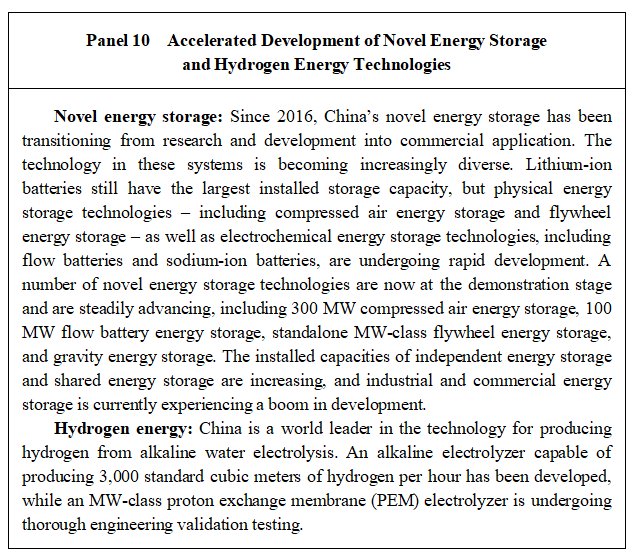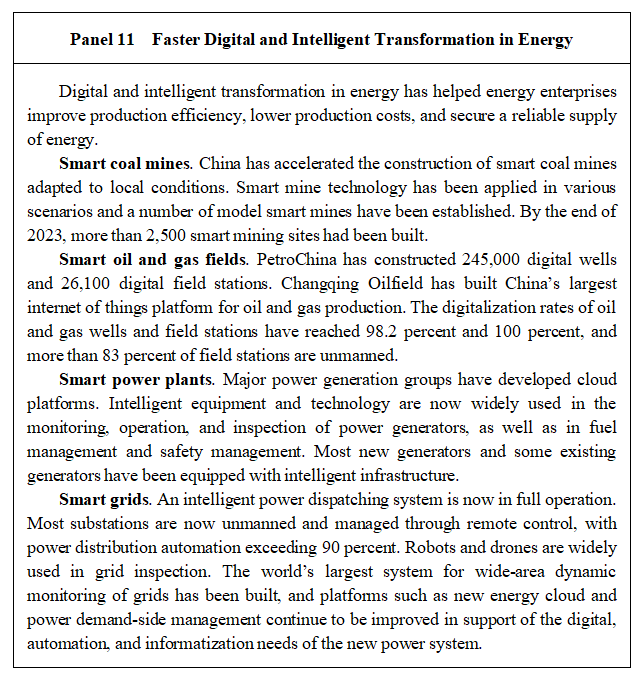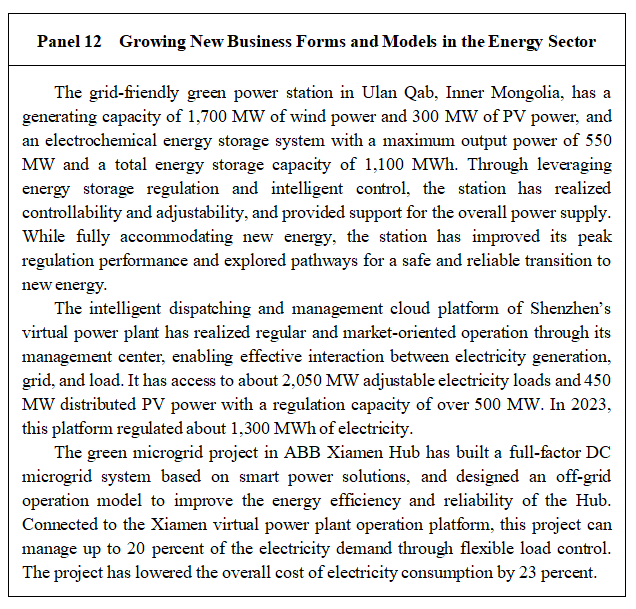Xinhua | August 29, 2024
IV. Developing New Quality Productive Forces in the Energy Sector
The rapid transition to green and low-carbon energy across the globe highlights the importance of technology. Technological innovation is the accelerator of energy transition leading the development of new quality productive forces in the energy sector. China has been intensifying its efforts to implement an innovation-driven development strategy in the sector. By leveraging its competitive industries, transforming and upgrading its traditional industries, and accelerating the cultivation of industries of the future, China has better coordinated the development of its industrial and innovation chains, and spurred innovation in its energy transition.
1. Improving the System for Innovation in Energy Technology
China is improving top-level design and overall plans to establish innovation as a primary driver in energy technology. It has accelerated efforts to build a synergetic and market-oriented innovation system which boosts the role of enterprises as the main players and expands coordination between production, education, research and application.
Strengthening synergetic technology innovation. China has improved top-level design and formulated plans for technological innovation, with the focus on key national nuclear power, oil and gas projects, and key research and development programs for advanced renewable energy technology, energy storage, smart power grids, hydrogen energy, and clean and efficient coal usage. Efforts have also been made to establish and improve key national energy laboratories, national engineering research centers, and R&D innovation platforms under the National Energy Administration. Through major energy projects, China has expedited technological innovation and the application of technological advances, and optimized collaboration models for breakthroughs in key energy technology and equipment, involving coordinated efforts between central and local governments, between government and enterprises, between universities and enterprises, and among research institutes.
Energizing innovators. China has strengthened the primary role of energy enterprises in technological innovation. It has encouraged leading enterprises to build innovation consortia to act as both sources of innovation and leaders of modern industrial chains. The country adopts an open competition mechanism for selecting the best candidates to undertake key energy technology projects and a multi-team research mechanism for finding the best pathways and achieving optimal results, with the purpose of motivating key R&D players in innovation. Policies have been improved to incentivize whoever makes the first breakthroughs in key technology and equipment, and pilot application of major technologies and equipment has been expedited. Innovative enterprises are also supported with preferential policies and better public services to grow into hubs of innovation.
2. Accelerating Technological Innovation in Energy Transition
Focusing on the cutting-edge technologies, key fields and strategic needs in the energy sector, China has been increasing its efforts to achieve breakthroughs in technology, develop new energy technologies and industries, and facilitate the transition to green energy from traditional sources.
Developing green energy technologies. China has built complete industrial chains for the R&D, design, and integrated manufacturing of wind and solar PV equipment. The high conversion efficiency of crystalline silicon/perovskite PV cell technology has established multiple world bests, and the conversion efficiency of advanced crystalline silicon PV cells in mass production has exceeded 25 percent. The maximum single-unit capacity of onshore wind turbines now exceeds 10 MW, and offshore wind turbines with a single-unit capacity of 18 MW have rolled off the production line. China has also become a front-runner throughout the hydropower industrial chain, from design and construction to equipment manufacturing. The world's largest hydropower generating units, each having an installed capacity of 1,000 MW, are in operation at the Baihetan Hydropower Station. The country has mastered the nuclear power technologies of third-generation pressurized water reactors (PWRs) as represented by Hualong One and Guohe One, as well as fourth-generation high-temperature gas-cooled reactors. Work has begun on Linglong One, a small modular PWR demonstration project. The country is also a world leader in smart grid technology, and has built a number of flexible DC transmission projects. Additionally, the development of novel energy storage and hydrogen energy technologies is accelerating.
Improving the clean and efficient utilization of traditional energy sources. China is applying supercritical and ultra-supercritical power generation and deep peak-shaving technologies in the coal-fired power industry to raise its environmental and energy efficiency indicators to world-leading standards. Advanced oil and gas exploration and production technologies have been industrialized, such as carbon dioxide flooding, horizontal drilling, and shale gas development, and significant progress has been made in deep-sea oil and gas exploration technologies. Shenhai-1, the world's first 100,000-tonne deep-sea semi-submersible oil production and storage platform, is operational, to help advance the green transformation and upgrading of the oil and gas industry.
3. Creating New Growth Points to Upgrade the Energy Sector
China is actively integrating digital technology into the energy sector and fostering new technologies, business forms and models to upgrade the energy sector and modernize industrial chains.
Transforming and upgrading the energy sector with digital and intelligent technologies. China has accelerated the application of digital and intelligent technologies to upgrade energy infrastructure for power plants, oil and gas fields, and coal mines, and to improve decision-making, operational efficiency, and service quality of enterprises. It has fast-tracked the construction of a new power system that allows information sharing among all entities across the generation-grid-load-storage chain. This enables panoramic perception, overall controllability, effective coordination between transmission and distribution grids, and real-time regulation of power supplies, which in turn improve the efficiency of power resource allocation and operational safety of the system. Plans are in place to create a digital end-use ecosystem, to build smart energy cities and communities, to improve the coordinated regulation and intelligence level of energy consumption systems, to unlock new models for smart energy use, and to upgrade green consumption with the digital economy.
Fostering new business forms and models in the energy sector. China has optimized and integrated its resources for electricity generation, grid infrastructure, and load management to build a new model of power supply based on close connectivity, coordination and interaction across the generation-grid-load-storage chain. Smart microgrids have been built for a variety of scenarios in the industrial, transport, construction and other sectors, allowing the local consumption of new energy. Virtual power plants have been created to increase the regulation capacity of the power system, and new integrated energy service models have been introduced to improve comprehensive energy efficiency, such as combined cooling, heating and power systems for natural gas utilization, geothermal power, distributed new energy, novel energy storage, and waste heat utilization.






